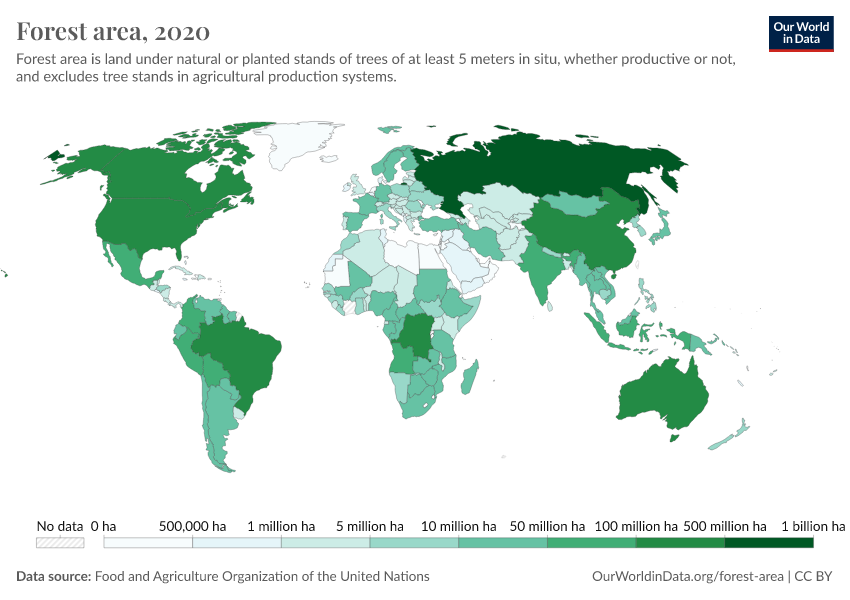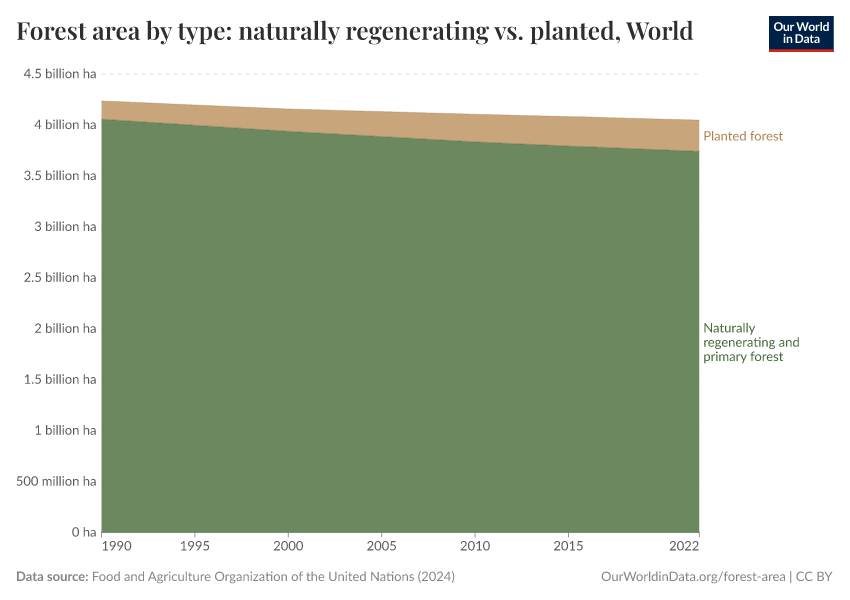Forest area
See the distribution of global forests and which countries have the most forest cover.
Global forests
How much of the earth's surface is forested?
How much of the world’s land surface today is covered by forest?
In the visualization, we see the breakdown of global land area.
10% of the world is covered by glaciers, and a further 19% is barren land – deserts, dry salt flats, beaches, sand dunes, and exposed rocks. This leaves what we call ‘habitable land’.
Forests account for a little over one-third of habitable land area. This is around one-quarter of total (both habitable and uninhabitable) land area.
This marks a significant change from the past: global forest area has reduced significantly due to the expansion of agriculture. Today, half of global habitable land is used for farming. The area used for livestock farming, in particular is equal in area to the world’s forests.
How are our forests distributed across the world regions?
This visualization shows the breakdown of global forest area by world region.
We see that Europe – dominated by forests across Russia – holds the greatest share of global forests. They are home to one-quarter of the world’s forest area.
This was followed by South America, which has one-fifth of forest area.
Country-by-country: Forests across the world
What share of each country is forested?
This interactive map shows the share of the total land area that is covered by forest.
Total forest area by country
This interactive map shows the total area of forest cover as measured in hectares (ha).
Russia is home to the largest area of forest – over 800 million hectares.
Brazil, the United States, Canada, China, Australia, and the Democratic Republic of Congo also have large areas of forested land – more than 100 million hectares each.
What share of the world’s forests does each country have?
This interactive map shows each country’s share of global forest area.
Russia – which has the largest forest area – is home to one-fifth of global forest area. Brazil is the only other country with more than 10% of global forest cover.
Types of forest
Primary vs. planted forest
We previously looked at the total forest area across the world. But within this total, there are multiple types of forest: primary forests, which have not been disturbed by human activities versus regenerated or planted forests.
This visualization looks at the breakdown of forests by type. The definitions for these categories – as defined by the UN Food and Agriculture Organization (FAO) – are given below.
Primary forest:
“Naturally regenerated forest of native species, where there are no clearly visible indications of human activities and the ecological processes are not significantly disturbed.”
Naturally regenerated forest:
“Naturally regenerated forest where there are clearly visible indications of human activities.
Includes selectively logged-over areas, areas regenerating following agricultural land use, areas recovering from human-induced fires, etc.”
Planted forest:
“Forest predominantly composed of trees established through planting and/or deliberate seeding.”
Cite this work
Our articles and data visualizations rely on work from many different people and organizations. When citing this article, please also cite the underlying data sources. This article can be cited as:
Hannah Ritchie (2021) - “Forest area” Published online at OurWorldinData.org. Retrieved from: 'https://ourworldindata.org/forest-area' [Online Resource]BibTeX citation
@article{owid-forest-area,
author = {Hannah Ritchie},
title = {Forest area},
journal = {Our World in Data},
year = {2021},
note = {https://ourworldindata.org/forest-area}
}Reuse this work freely
All visualizations, data, and code produced by Our World in Data are completely open access under the Creative Commons BY license. You have the permission to use, distribute, and reproduce these in any medium, provided the source and authors are credited.
The data produced by third parties and made available by Our World in Data is subject to the license terms from the original third-party authors. We will always indicate the original source of the data in our documentation, so you should always check the license of any such third-party data before use and redistribution.
All of our charts can be embedded in any site.




